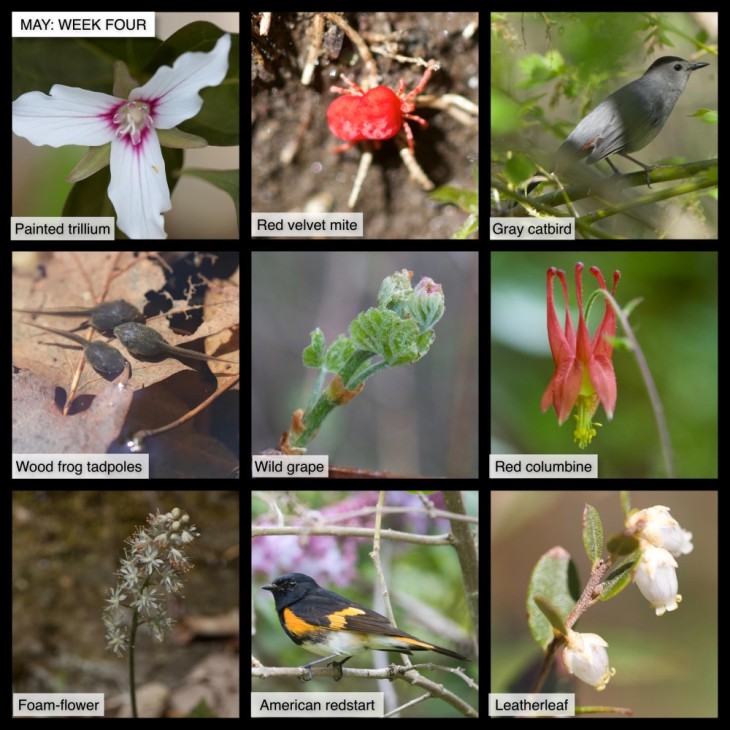This week in the woods, the forest floor has become noticeably darker. It is also getting drier. As trees and other plants unfurl their leaves, they’re pulling up a lot of moisture from the soil.
A fun way to observe that upward water flow is to cut the woody vine of a wild grape and put a jar beneath the cut end to catch dripping sap. We tried this on Sunday, and collected over two cups of sap in one hour. Also notice the wild grape’s buds, which are starting to open now. This Outside Story essay from Robbie Meyers includes advice on when to forage leaves. Here’s The Native Plant Trust’s profile of the species in the photo (one of several wild grapes growing in our region), Vitis riparia, or river grape.
Vernal pools are also warming up, and their rising temperature is causing wood frog tadpoles to develop more quickly. Look for them sunning on top of submerged leaves. Here’s a great short film from NatureNorth, documenting the progression from freshly laid eggs to froglets in just seven weeks.
This late in May, many of our spring ephemerals have dropped their flowers. However, painted trillium and red columbine have just come into bloom. An Outside Story article about trillium appears on our website this week. An interesting note about columbine species in general – according to this page from the U.S. Forest Service, columbines are recent arrivals to North America. They showed up during the Pleistocene, and rapidly diversified into a range of North American species.
Two other exquisite wildflowers blooming right now – though you’ll have to take a close look to fully admire them – are foam-flower and leatherleaf, a common wetland plant. Here’s more information about foam-flower from Adirondacks Forever Wild, and a profile of leatherleaf from Minnesota Wildflowers.
With trees leafing out, it’s getting much more difficult to see (or photograph) many songbirds, but here are two easier finds. Gray catbirds are frequent visitors to yards – they’re big gray birds with black caps and, as the name implies, a mewing call. They also mimic other birds. Here’s a fun video from the Cornell Lab of Ornithology, documenting an encounter with a male catbird that had mastered an extensive repertoire of other bird (and frog!) sounds. Why does a male catbird do this? Maybe, suggests audio curator Greg Bundy, he’s demonstrating to females that he’s survived long enough to learn multiple calls.
Another bird we’ve seen frequently this week is the American redstart. The males are hard to miss – they’re vividly colored and inclined to showy territorial displays. Some facts from Audubon: the males may have more than one mate, and both parents care for the young. But instead of taking an “any open mouth will do” approach, the parents divvy up the brood, “each parent attending only half the fledglings.” This raises a question about food distribution: does Dad catch twice as many insects, or is it better for chicks to be on Team Mom?
We’ve also noticed red velvet mites crawling on rocks. This common name includes a number of mite species. Their intense color is likely aposematic, meaning that it serves as a warning to would-be predators. Here’s more information from the University of Wisconsin Milwaukee’s “Bug Lady.”
In this difficult period, many of us find joy in observing local nature, and many families are seeking outdoor enrichment opportunities for children. Here are nine photographs taken this past week in forests within 15 miles of the Northern Woodlands office in Lyme, New Hampshire. We hope you enjoy using this grid as a prompt for your own explorations, or as the basis for a game of family forest tic-tac-toe.
What are you seeing in the woods this week? Share your images with us on Facebook, or submit a special photo for possible inclusion in our monthly online Reader Photo Gallery.



Discussion *